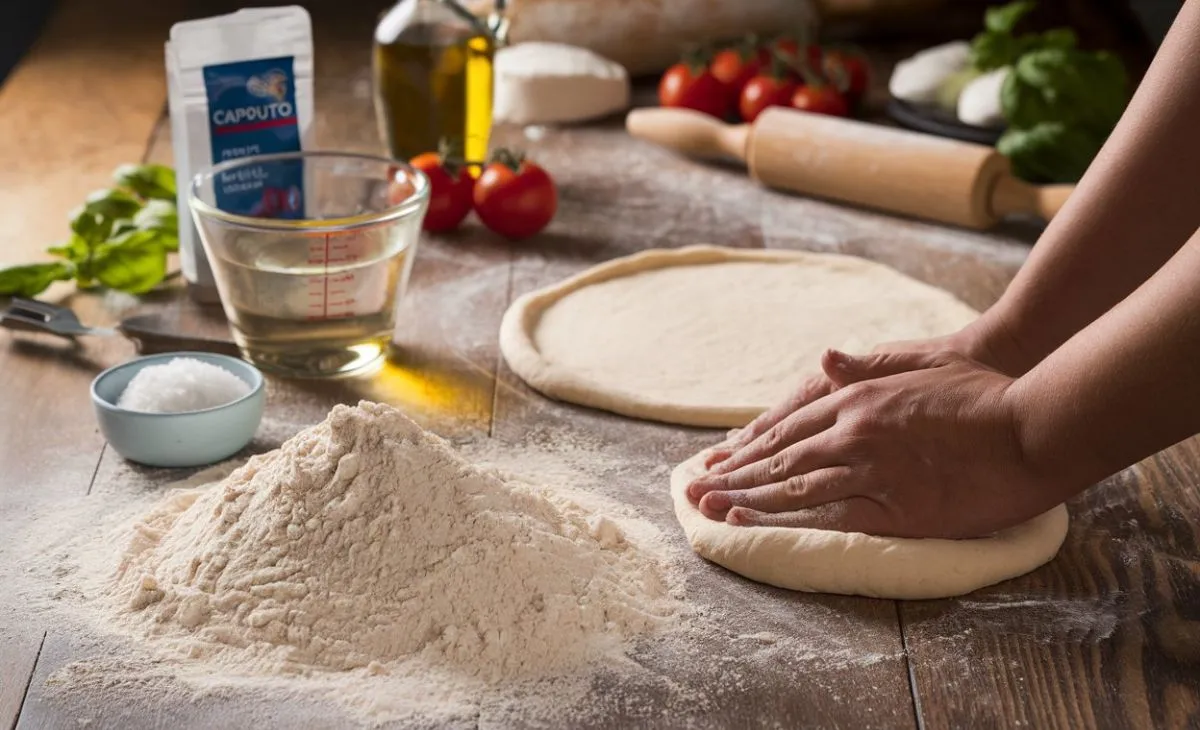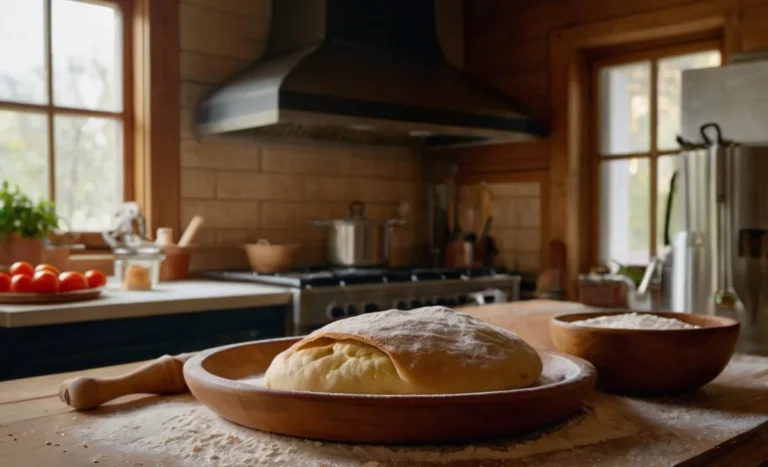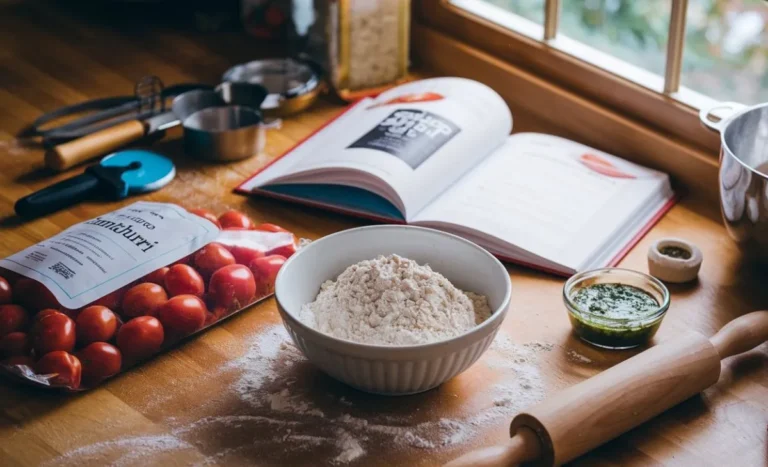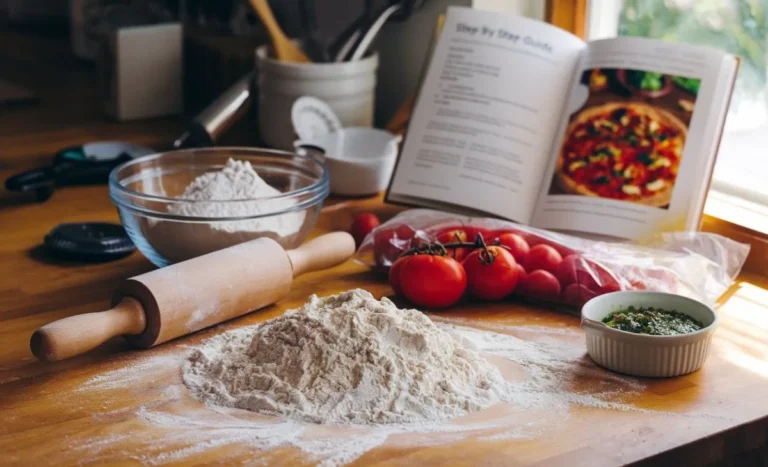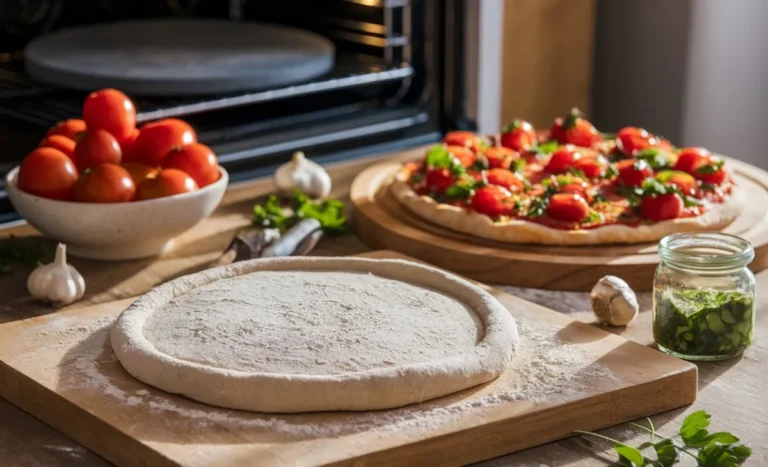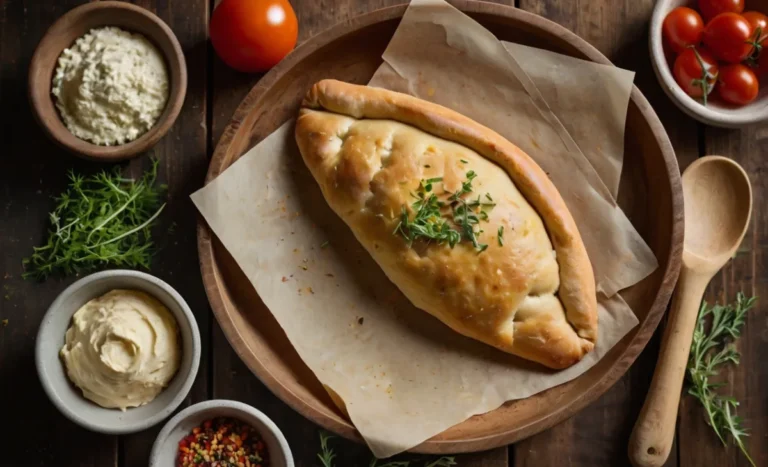Caputo Pizza Dough Recipe: The Ultimate Guide for Perfect Homemade Pizza
What is Caputo Pizza Dough?
Caputo pizza dough is widely recognized for its role in creating authentic, Neapolitan-style pizza. This dough is made from Caputo flour, an Italian brand known for its finely milled, high-quality wheat. Using Caputo flour gives pizza a unique texture, resulting in a light, airy crust with a chewy center. If you want to master the art of pizza making at home, the Caputo pizza dough recipe is your key to achieving restaurant-level results.
The standout feature of Caputo flour is its high gluten content. This gives the dough its elasticity, allowing it to stretch without tearing. Additionally, this elasticity makes the dough easy to work with, making it perfect for both beginners and seasoned pizza makers. With the right handling, your pizza crust will have the ideal balance between crispness and softness, a hallmark of traditional Neapolitan pizza.
Another key benefit of using the Caputo pizza dough recipe is the flour’s slow fermentation properties. Caputo flour supports long fermentation times, which enhances the dough’s flavor and improves its digestibility. This slow fermentation process allows the dough to develop natural sweetness and complex flavors, setting it apart from other types of pizza dough.
Overall, Caputo pizza dough is the go-to option for those aiming to make pizza that captures the true essence of Italy. From its easy handling to its superior texture and flavor, this dough will elevate your homemade pizza game. By mastering the Caputo pizza dough recipe, you’ll bring authentic, pizzeria-quality pizza to your kitchen.
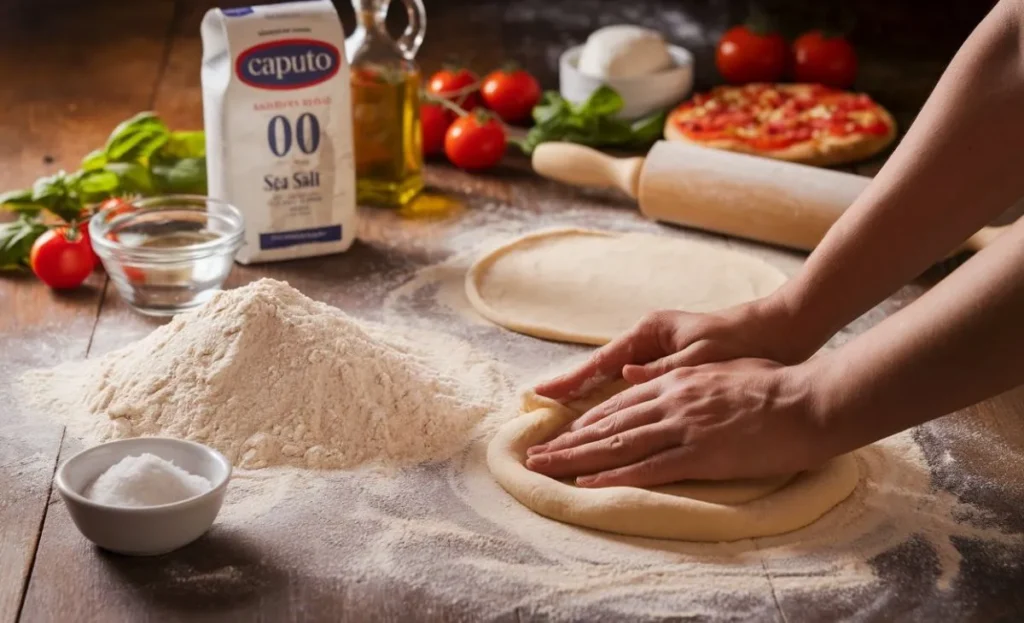
Ingredients You’ll Need for Caputo Pizza Dough
To create the perfect pizza crust, understanding the ingredients in the Caputo pizza dough recipe is essential. Each component plays a crucial role in shaping the dough’s texture and flavor. From the finest Caputo flour to the right amount of yeast, every ingredient contributes to a superior pizza base. Knowing how to balance these ingredients will ensure your pizza comes out just right every time.
The star of the Caputo pizza dough recipe is Caputo 00 flour, an Italian flour milled to a fine texture. This finely milled flour is ideal for pizza dough because it absorbs water efficiently, leading to a soft and elastic dough. Caputo 00 flour also ensures a light, airy crust that is crispy on the outside and chewy in the middle, making it perfect for authentic Neapolitan pizza.
Water is another key ingredient in the dough-making process. The water helps activate the yeast, which is essential for the dough to rise. It also hydrates the flour, allowing gluten to form and giving the dough its characteristic stretchiness. Using room temperature water is ideal for the Caputo pizza dough recipe, as it ensures proper fermentation without over-stressing the yeast.
Finally, salt and yeast are vital to the success of the dough. Salt adds flavor while controlling yeast activity, preventing the dough from rising too quickly. Yeast, on the other hand, helps the dough rise and adds a subtle tang to the flavor. Together, these ingredients work in harmony to create a dough that is both flavorful and easy to work with. By mastering these basics, you’ll elevate your homemade pizza experience.
Step-by-Step Guide to Making Caputo Pizza Dough
Making homemade pizza with the Caputo pizza dough recipe is easier than you might think. With the right ingredients and a simple process, you can create a delicious, authentic pizza crust in your kitchen. This step-by-step guide will walk you through the process, ensuring you get the perfect dough texture every time. Follow these instructions to enjoy restaurant-quality pizza from the comfort of your home.
Ingredients:
- 500g Caputo 00 flour
- 325ml room temperature water
- 10g sea salt
- 3g active dry yeast
- 1 tbsp olive oil (optional)
Step 1: Activate the Yeast
In a small bowl, dissolve the yeast in 50ml of warm water. Let it sit for 5-10 minutes until it becomes frothy. This step ensures the yeast is active and ready to help your dough rise.
Step 2: Mix the Ingredients ️
In a large bowl, combine the Caputo flour and sea salt. Slowly pour in the yeast mixture and remaining water, mixing everything together. If you like a bit of added richness, drizzle in the olive oil. Stir the dough with a wooden spoon until it starts coming together.
Step 3: Knead the Dough
Transfer the dough to a lightly floured surface. Knead it for about 10 minutes until it becomes smooth and elastic. This step is crucial for developing the gluten, which will give your pizza that perfect chewiness.
Step 4: Let the Dough Rise ⏳
Place the dough in a clean, oiled bowl and cover it with a damp cloth. Let it rise in a warm place for 6-8 hours or overnight. The longer the dough rests, the better the flavor and texture will be.
Step 5: Shape and Bake
After the dough has doubled in size, punch it down and divide it into portions. Shape each piece into a pizza base, top with your favorite ingredients, and bake at 475°F (245°C) for 10-12 minutes until golden and crispy.
Now, you’re ready to enjoy the fruits of your labor! With this Caputo pizza dough recipe, you’ll be making pizza that tastes just like it came from a traditional pizzeria.
Tips for Achieving the Perfect Dough Consistency
Achieving the ideal dough consistency is key to mastering the Caputo pizza dough recipe. The right balance of ingredients and techniques will give your dough a smooth, elastic texture that’s easy to work with and bakes to perfection. Whether you’re new to pizza-making or looking to improve your skills, following a few simple tips will ensure your dough reaches the perfect consistency every time.
First, proper hydration is essential for good dough. The water-to-flour ratio should be carefully measured to avoid overly sticky or dry dough. Typically, Caputo flour requires about 65% hydration, meaning you’ll need 325ml of water for every 500g of flour. Mixing the ingredients slowly allows the flour to fully absorb the water, resulting in a softer and more pliable dough.
Second, kneading is crucial for developing the gluten structure, which gives the dough its elasticity. When kneading, aim for a smooth, slightly tacky texture that doesn’t stick to your hands. Be patient and knead for at least 10 minutes to properly activate the gluten. Over-kneading, however, can make the dough tough, so it’s important to find the right balance.
Lastly, temperature plays a significant role in dough consistency. Cold ingredients can slow down yeast activation, resulting in a stiffer dough. Using room-temperature water and allowing the dough to rise in a warm environment helps achieve a light, airy crust. Always give your dough enough time to ferment and relax, which will make it easier to shape and result in a better final texture.
How to Properly Rest and Ferment Caputo Pizza Dough
Resting and fermenting your dough is crucial to mastering the Caputo pizza dough recipe. These steps allow the dough to develop flavor, texture, and structure, transforming a simple mixture of flour and water into the perfect pizza base. With the right resting and fermentation techniques, you’ll enhance the dough’s natural flavors while creating a soft, elastic crust that’s easy to work with and bake.
The first step in proper fermentation is allowing the dough to rise at room temperature. After kneading, place the dough in a lightly oiled bowl and cover it with a damp cloth. Let it sit for 6-8 hours or even overnight. This slow fermentation allows the yeast to work gradually, producing a dough that’s light, airy, and full of flavor. The longer the fermentation time, the more complex the dough’s taste will become.
Cold fermentation is another method for enhancing the Caputo pizza dough recipe. After the initial rise, you can refrigerate the dough for up to 48 hours. Cold fermentation slows down yeast activity, resulting in a more digestible dough with a deeper, tangier flavor. When you’re ready to bake, simply let the dough come to room temperature for about an hour before shaping and topping it.
Lastly, don’t rush the final step of resting the dough before baking. After shaping the dough into a pizza base, allow it to rest for 10-15 minutes. This final rest helps the gluten relax, making it easier to stretch the dough without tearing. It also ensures a tender, crispy crust once baked. By properly resting and fermenting your Caputo pizza dough, you’ll achieve a crust that’s flavorful, chewy, and perfectly textured.
Baking Techniques for Authentic Pizza with Caputo Dough
Baking your pizza correctly is just as important as preparing the dough in the Caputo pizza dough recipe. The right baking techniques ensure your crust comes out perfectly crisp on the outside and tender on the inside. With Caputo dough, you’ll want to focus on high heat and quick baking times to capture that authentic Neapolitan-style pizza. Follow these steps to bake your pizza like a pro.
First, preheating your oven to the highest possible temperature is essential. Most home ovens reach around 500°F (260°C), which works well for baking Caputo pizza dough. For an even better result, use a pizza stone or steel, which will mimic the effects of a traditional pizza oven. Place the stone in the oven while preheating, so it absorbs heat evenly, allowing your dough to bake quickly and develop a crispy base.
Next, when transferring your pizza to the oven, use a pizza peel dusted with flour or cornmeal to prevent sticking. Quickly slide the dough onto the preheated stone or steel, and keep an eye on it. Authentic pizza made with the Caputo pizza dough recipe should bake in about 8-12 minutes, depending on your oven’s temperature. The high heat will cause the dough to puff up, creating those signature airy pockets and a perfectly blistered crust.
Finally, resist the urge to overbake your pizza. Caputo dough is designed to cook fast, resulting in a golden-brown crust with a slightly charred exterior. Once the edges are crispy, and the toppings are bubbling, remove the pizza from the oven. Let it cool for a few minutes before slicing to ensure the toppings set and the crust retains its perfect texture. By following these baking techniques, your Caputo pizza dough will deliver an authentic pizzeria experience right at home.
Common Mistakes to Avoid When Making Caputo Pizza Dough
Making the perfect pizza crust with the Caputo pizza dough recipe requires attention to detail, and avoiding common mistakes is crucial for success. Even small errors can impact the texture, flavor, and rise of your dough. By understanding and sidestepping these pitfalls, you’ll be able to create a flawless pizza crust every time. Here are a few common mistakes to watch out for.
First, using the wrong flour can affect the dough’s consistency and rise. Caputo flour is specifically milled for pizza dough, offering a fine texture and high gluten content. Using all-purpose flour or other substitutes can result in a less elastic and chewy crust. To achieve the authentic Neapolitan-style pizza, always stick with Caputo 00 flour.
Another frequent mistake is adding too much flour when kneading. Many people add extra flour to prevent the dough from sticking, but this can make the dough dense and tough. Instead, work on a lightly floured surface and be patient while kneading. The dough should be soft and slightly tacky, but not overly sticky. Over-flouring will prevent the dough from developing the ideal texture.
Lastly, rushing the fermentation process is a common error. Allowing the dough to ferment slowly, whether at room temperature or in the fridge, is crucial for developing flavor and structure. If you cut the resting time short, your dough may be flat and lack the characteristic airy pockets. Patience is key when following the Caputo pizza dough recipe, as proper fermentation results in a light, flavorful crust.
By avoiding these common mistakes, you’ll ensure that your Caputo pizza dough turns out perfect every time. From using the right flour to mastering fermentation, each step plays a crucial role in creating the ideal pizza crust.
Exploring Creative Cottage Cheese and Egg Recipes: Healthy and Tasty Dishes to Try

